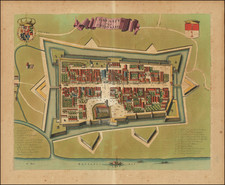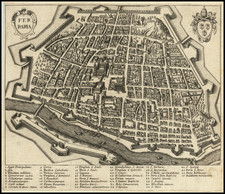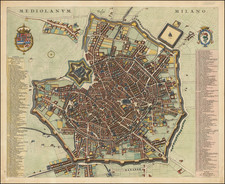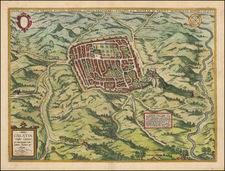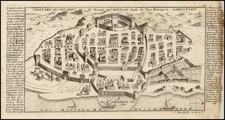Very rare English chart of the Bay of Naples, by Andrew Elton, in superb contemporary hand-color.
Engraved sea chart of Naples, with integral town views. The chart, by Andrew Elton, includes a dedication to Charles Frye.
The chart shows the Bay of Naples from the Island of Ischia to Cabrata Island (Capri). Mount Vesuvius is depicted in eruption, touring over the city. Numerous bearings on shown in the bay and many smaller port towns are named. Views of three islands are provided at the base of the map.
In 1730 and 1731, the English merchant mariner Captain Andrew Elton Jr. issued a series of sea charts of harbors and coastal locations that he had visited during his voyages to the Mediterranean Sea. Each chart was masterfully engraved by Bishop Roberts, an artist who subsequently emigrated to America, where he produced one of the most important early views of Charleston, SC.
The chart includes four engraved coastal profiles at the bottom of the image, as well as the following description of Naples:
Naples, one of the largest finest & most flourishing Cities in all Italy, is Seated on a Gulf of the same Name & has a Spacious and large Road on the Mediterranean The Sea washes it on ye South Side On ye North are little Hills which rise insensibly into Compania Faelix on the East is a Plain which leads to Mount Vesuvius and on the West the upper Town This City is defended by 3 Castles & adorn'd with a vast Number of Palaces Churches Monasteries Publick Fountains. The King of Spain used to appoint a Vice Roy who was Chang'd generally Every three Years but now they are Subject to the Emperor. About 8 Miles from Naples is the famous Mount Vesuvius noted for its Continual Fires. It has had Twelve dreadful Eruptions since the birth of Jesus Christ particularly wherein Pliny the Elder Lost his Life and another noted on in 1631 when the Sea retir'd Several Paces and Streams of Fire & burning Liquid matter ran thereinto Many Villeges were then overthrown above 3000 Persons wth. a vast Number of Cattle perish'd & Naples itself was threatned wth. a general Destruction However Mr. Misson assures us yt. the Country there abouts is very Rich & ye East Side of ye Mountain it Self bears abundance of good Vines so yt. from thence we have ye famous Greco Malateste and Lochryme Christi.
Rarity
This is the second known copy, after that held by the British Library. We are aware of only two institutional holdings of Elton charts. The British Library holds examples of the sheets containing the charts of Corve & Zea; Livorno; Charella & Stromboli; Salonica; Naples; and Gallipoli, Lipari & Milazzo. The Richard M. Daly Library at the University of Illinois-Chicago holds the charts of Corve & Zea; Livorno; Charella & Stromboli; Salonica, Gallipoli, Lipari & Milazzo and Smyrna.
Andrew Elton, Junior (fl. 1715-42) was an English merchant mariner who specialized in trade between Britain and Italy and the Ottoman Empire. While clearly a successful businessman and gentleman of prominence, much of his biography remains a mystery. He was the son of Captain Andrew Elton, Senior (1647-1710), a privateer originally from Rotherhithe, Surrey (now in London). Elton Senior was given royal letters of marque, and primarily prayed on French ships in Newfoundland and the English Channel. He was captain of the Russell Galley from the 1695 until 1703, and then the Godfrey Galley until his death, which occurred off of Land's End while he was attempting to take a French ship.
Andrew Elton, Junior, inherited £150 from his father, and eventually the captaincy of the Godfrey Galley. As purchasing, maintaining and crewing such a vessel was extremely expensive, mariners such as Elton usually relied on investors to finance their endeavors, in return for a share of some of the expedition's profits. These inventors tended to be highly prominent figures, such as directors of charted trading companies and politicians, several of which are the named dedicates of Elton's charts. Unlike his father, who largely relied on privateering, Andrew Junior was principally concerned with mercantile trade. The first definitive reference to him concerns his donation of £15 towards the construction of the Parish Church of St. Mary's, Rotherhithe, which was completed in 1715 (E.J. Beck, Memorials to Serve for a History of the Parish of St. Mary, Rotherhithe, London, 1907, p.156).
Andrew Elton Junior was based in Deal, Kent for most of his career, and was known to be captain of at least four different ships. He was associated with the Levant Company (also called the Turkey Company), a royal chartered private syndicate that had held a monopoly on the English trade with the Ottoman Empire since 1580s. He also traded heavily with the port of Livorno (Leghorn), a key entrepot for goods from throughout the Mediterranean.
The first reference to Captain Elton Junior's maritime activities appears in The Post Boy, April 18, 1719, which notes that "Godfrey Galley, Capt. Elton" arrived into Deal "from Leghorn". From that point onwards until 1742, various newspaper announcements record Elton's visits to Livorno (numerous), Messina, Naples, Smyrna, Iskenderun and Alexandria. From 1719 to 1726, he was captain of the Godfrey Galley (and briefly in 1726 the Caesar Galley), while from 1726 to 1731 he was skipper of the Hadley Galley and then the Nile Galley from 1731 onwards. The latest definitive reference to Elton notes that he was an 'Annual Governor' (i.e. Benefactor) of the London Infirmary in 1742 (I. Maddox, The Duty and Advantages of Encouraging Public Infirmaries, London, 1743, p.34).
The engraver of Elton's charts , Bishop Roberts (d.1739), is best known for his historically important view of Charlestown, South Carolina. Roberts was evidently a highly-skilled engraver who seems to have specialized in heraldic devices, as evidenced by the fine arms and cartouches on Elton's charts. In 1728-9 he is recorded as working in London, having the engraver Henry Copeland as his apprentice. By 1733, he appears in New Jersey, where he fulfilled an engraving commission, and by 1735 he had moved to Charleston, South Carolina. Around 1738, he drafted a view of Charleston that is today considered to be one of the most important early records of the city. This view was subsequently published as An Exact Prospect of Charlestown, the Metropolis of the Province of South Carolina, in the London Magazine (1762).









![[ Torino / Turin Battle Plan ] Plan de la Ville et Citadelle de Turin Assiegees par l'Armee de France. le 3e Juin 1706 et Secourues par leurs Altes ses Royale et Serenissme de Savoye, le 7.e. Septembre de la meme Annee . . .](https://storage.googleapis.com/raremaps/img/small/80453.jpg)
